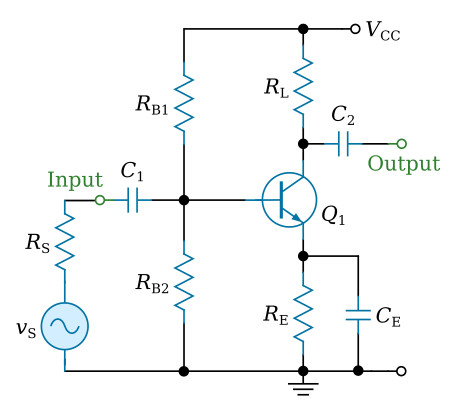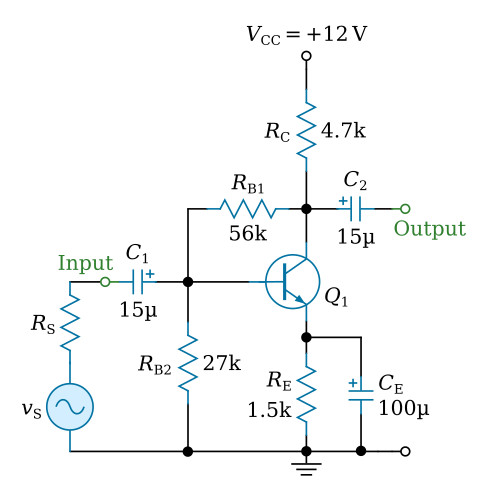Home > Textbooks > Basic Electronics > Audio Amplifiers > Preamplifiers >
Audio Amplifiers
Preamplifiers
Preamplifiers are low-level stages that usually follow low-level output transducers such as microphones, hearing-aid pickup devices, and recorder-reproducer heads.
The most important characteristics of preamplifiers are the signal-to-noise level (noise factor), the input and output impedances, and the required frequency response.
Transistor amplifiers were discussed in a general manner in the previous sections. This section will review some of the more specific design considerations and will illustrate them with practical circuits.
The circuit shown in the figure below is the basic amplifier — a class A, common-emitter, transistor, single-stage type. It is used primarily for voltage amplification (preamplifier). However, by proper choice of load, it can also be used as a current or power amplifier.

The optimum design for such an amplifier must take into consideration a number of variables. These include maximum voltage and dissipation limitations of the transistor, the amount of power available from the source and its effective impedance, the power to be delivered to the succeeding stage and its impedance, the linear portion of the transistor's characteristics, the loading effect of the stage on the source of drive and current, and temperature stabilization — to name just a few. With so many variables, it is little wonder computers are sometimes employed to work out a set of values that will best satisfy most conditions. However, it is possible to work out some very satisfactory designs, using much simpler methods. These methods require a minimum of facts before-hand and involve nothing more than a small amount of arithmetic. They were described in one of the previous sections.
The second single-stage audio amplifier is shown in the figure below. This circuit is again a class A, common-emitter, transistor amplifier. The operating (quiescent) current of this amplifier is 1 mA. The DC current is held constant against temperature variation by both the shunt degenerative action of RB1 and the series emitter degeneration action of RE. Note that there is a voltage drop of 1.5 V across RE.

The DC voltage drop across RC is such that the quiescent collector voltage is approximately half the supply voltage. This bias will give maximum dynamic range, because the instantaneous voltage may now swing from zero up to the supply voltage. RE is bypassed to avoid AC degeneration. However, RB1 is not bypassed. This shunt degeneration linearizes but reduces the current gain, reduces the input and output impedances, and extends the frequency response. Greater amount of negative feedback is effected when the load or source impedance is higher. As a voltage amplifier, the source impedance is low and hence the shunt feedback becomes less effective. This amplifier is suitable as a general purpose amplifier building block.






